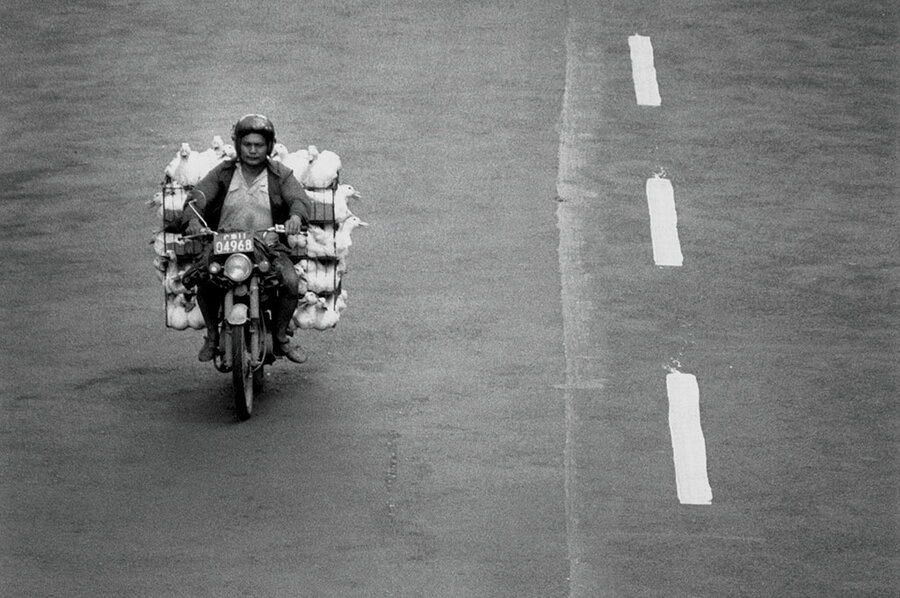How I got my Thanksgiving wish
Loading...
When I was a child, I looked forward to my family’s Thanksgiving Day dinners, not so much for the food but for the tradition of the wishbone. Sitting at the table, I would eagerly watch as Dad carved. Each slice of the knife would bring him closer to revealing what I had waited for all year. Finally, he’d pull out the wishbone and announce, “So, who wants a wish?”
I remember the excitement of grabbing one end of the bone as another family member took the other. “One, two, three ... pull!” we’d shout. A quick tug and – “snap!” – the wish would supposedly be granted to the one with the longer piece.
I had longed to re-create this Thanksgiving tradition in my college-level English language classroom in Luzhou, in southeastern China. Yet while the city’s outdoor markets were full of chickens, ducks, and even pigeons and doves, when it came to bigger fowl, forget it. Like a majority of Chinese, Luzhou’s Yangtze River folk were not into turkeys. I contented myself with teaching the history of Thanksgiving and leaving the rest up to Norman Rockwell, whose Thanksgiving magazine prints I posted on the blackboard.
But one year, on a visit back to the States, I had a brainstorm. Why not take a turkey wishbone back to China and give my students a real Thanksgiving Day? The students and I could decorate the classroom. We could set up tables with centerpieces. We could bring our lunches from the student cafeteria and eat together as a class. And for the grand finale, we could hold a drawing to see who would participate in the wishbone tradition.
The more I thought about it, the more enthusiastic I became. I enlisted the help of my parents, and together we prepared a large turkey with a magnificently large wishbone. After cleaning and drying my prize, I carefully wrapped it in tissue paper. Off the two of us went to China.
For months I guarded that wishbone. Whenever I passed the drawer in which it was nestled, I’d peek inside to make sure it was safe. No mold. No breaks. No mouse nibbles.
Come November, I was convinced that my wishbone would make Thanksgiving come alive for my Chinese college crowd.
When the fourth Thursday in November finally came, everyone was anticipating our noontime celebration. The excited students gathered in the classroom and awaited my early arrival for decorating. In my campus apartment, I busily assembled the holiday items I had painstakingly collected just for this occasion.
Into the box they went: Thanksgiving Day banners, turkey door hangings, tablecloths, and autumn-themed centerpieces. On the very top, in a plastic sandwich bag, was the precious turkey wishbone I had so diligently guarded for so many months. I set the box by the front door and went about getting ready to leave.
Teachers develop an uncanny ability for detecting suspicious sounds, so when the rustling began, I knew something was up.
I quickly made my way to the box. There stood Little Flower, my Chihuahua. A ripped sandwich bag was at her feet, and clamped between her jaws was the precious wishbone.
“Little Flower,” I warned, “you give me that.”
My dog stood her ground.
“Drop it!”
Her jaws tightened.
Slowly, I reached out and gripped the exposed end of the bone. I gave a careful tug.
Little Flower tugged back.
I tugged again.
Little Flower did the same.
No matter how gently I pulled, Little Flower pulled harder until ... SNAP! The wishbone broke in two.
And wouldn’t you know it, I had the shorter end.
I was certain my planned event was ruined. I had invested such emotional weight in the wishbone that having a satisfying Thanksgiving celebration without it seemed a faint hope. But the fact was that the students had far too much fun decorating, eating together, and enjoying the festive atmosphere to remember my tradition. And as I partook of their jovial community, I realized there had never been any need for a turkey wishbone to bring Thanksgiving to my Chinese classroom. Holidays are not made by the things we prepare but by the people we’re with.
As Thanksgiving Day approaches once again, I am planning another noontime gathering with yet another class. Given my previous success, I’ve learned not to place too much stock in wishbones.
After all, even though the dog got the longer end of the wishbone, I got my wish.







